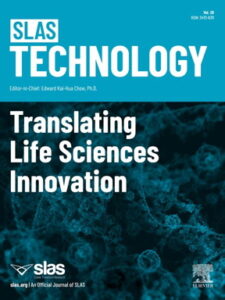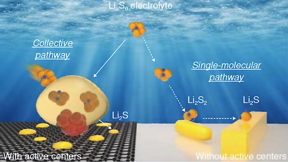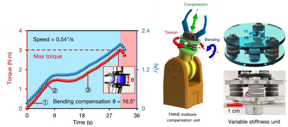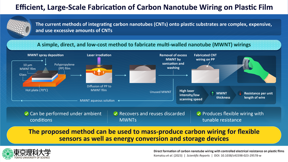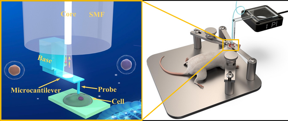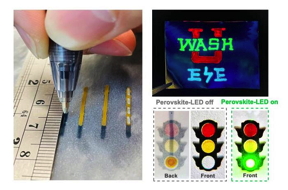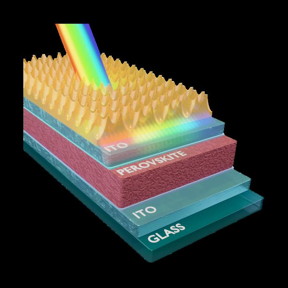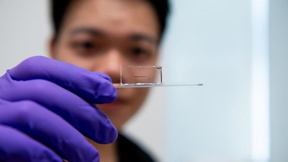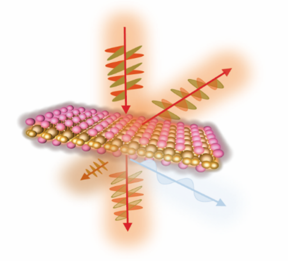Home > Press > Implantable device shrinks pancreatic tumors: Taming pancreatic cancer with intratumoral immunotherapy
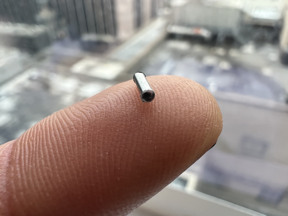 |
| Houston Methodist Research Institute nanomedicine researchers used an implantable nanofluidic device smaller than a grain of rice to deliver immunotherapy directly into a pancreatic tumor. CREDIT Houston Methodist |
Abstract:
Houston Methodist nanomedicine researchers have found a way to tame pancreatic cancer - one of the most aggressive and difficult to treat cancers - by delivering immunotherapy directly into the tumor with a device that is smaller than a grain of rice.
Implantable device shrinks pancreatic tumors: Taming pancreatic cancer with intratumoral immunotherapy
Houston, TX | Posted on April 14th, 2023In a paper recently published in Advanced Science, Houston Methodist Research Institute researchers used an implantable nanofluidic device they invented to deliver CD40 monoclonal antibodies (mAb), a promising immunotherapeutic agent, at a sustained low-dose via the nanofluidic drug-eluting seed (NDES). The result, found in murine models, was tumor reduction at a fourfold lower dosage than traditional systemic immunotherapy treatment.
“One of the most exciting findings was that even though the NDES device was only inserted in one of two tumors in the same animal model, we noted shrinkage in the tumor without the device,” said Corrine Ying Xuan Chua, Ph.D., co-corresponding author and assistant professor of nanomedicine at Houston Methodist Academic Institute. “This means that local treatment with immunotherapy was able to activate the immune response to target other tumors. In fact, one animal model remained tumor-free for the 100-days of continued observation.”
Pancreatic ductal adenocarcinoma is frequently diagnosed at advanced stages. In fact, about 85% of patients already have metastatic disease at diagnosis.
The Houston Methodist researchers are studying similar nanofluidic delivery technology on the International Space Station. Grattoni’s nanomedicine lab at Houston Methodist focuses on implantable nanofluidics-based platforms for controlled and long-term drug delivery and cell transplantation to treat chronic diseases.
Immunotherapy holds promise in treating cancers that previously did not have good treatment options. However, because immunotherapy is delivered throughout the entire body, it causes many side effects that are sometimes long-lasting, if not life-long. By focusing the delivery directly into the tumor, the body is protected from being exposed to toxic drugs and fewer side effects, essentially allowing patients undergoing treatment to have a better quality of life.
“Our goal is to transform the way cancer is treated. We see this device as a viable approach to penetrating the pancreatic tumor in a minimally invasive and effective manner, allowing for a more focused therapy using less medication,” said Alessandro Grattoni, Ph.D., co-corresponding author and chair of the Department of Nanomedicine at Houston Methodist Research Institute.
The NDES device consists of a stainless-steel drug reservoir containing nanochannels, thus creating a membrane that allows for sustained diffusion when the drug is released.
Other medical technology companies offer intratumoral drug-eluting implants for cancer therapeutics, but those are intended for shorter duration use. The Houston Methodist nanofluidic device is intended for long-term controlled and sustained release, avoiding repeated systemic treatment that often leads to adverse side effects.
Additional lab research is underway to determine the effectiveness and safety of this delivery technology, but researchers would like to see this become a viable option for cancer patients in the next five years.
Houston Methodist Research Institute collaborators on this study include Hsuan-Chen Liu, Daniel Davila Gonzalez, Dixita Ishani Viswanath, Robin Shae Vander Pol, Shani Zakiya Saunders, Nicola Di Trani, Yitian Xu, Junjun Zheng and Shu-Hsia Chen.
This research received funding support from the Golfers Against Cancer and the National Institutes of Health (NIH-NIGMS R01GM127558).
For more information about Houston Methodist, visit houstonmethodist.org. Follow us on Twitter, Facebook and On Health.
For more information: Sustained Intratumoral Administration of Agonist CD40 Antibody Overcomes Immunosuppressive Tumor Microenvironment in Pancreatic Cancer. Advanced Science. Online Jan. 19, 2023. Hsuan-Chen Liu, Daniel Davila Gonzalez, Dixita Ishani Viswanath, Robin Shae Vander Pol, Shani Zakiya Saunders, Nicola Di Trani, Yitian Xu, Junjun Zheng, Shu-Hsia Chen, Corrine Ying Xuan Chua andAlessandro Grattoni. DOI: 10.1002/advs.202206873
####
For more information, please click here
Contacts:
Gale Smith
Houston Methodist
Office: 832-667-5843
Cell: 2816270439
Copyright © Houston Methodist
If you have a comment, please Contact us.Issuers of news releases, not 7th Wave, Inc. or Nanotechnology Now, are solely responsible for the accuracy of the content.
| Related Links |
| Related News Press |
News and information
![]() New family of wheel-like metallic clusters exhibit unique properties April 14th, 2023
New family of wheel-like metallic clusters exhibit unique properties April 14th, 2023
![]() Efficient heat dissipation perovskite lasers using a high-thermal-conductivity diamond substrate April 14th, 2023
Efficient heat dissipation perovskite lasers using a high-thermal-conductivity diamond substrate April 14th, 2023
![]() Nanobiotechnology: How Nanomaterials Can Solve Biological and Medical Problems April 14th, 2023
Nanobiotechnology: How Nanomaterials Can Solve Biological and Medical Problems April 14th, 2023
![]() New Developments in Biosensor Technology: From Nanomaterials to Cancer Detection April 14th, 2023
New Developments in Biosensor Technology: From Nanomaterials to Cancer Detection April 14th, 2023
![]() IOP Publishing celebrates World Quantum Day with the announcement of a special quantum collection and the winners of two prestigious quantum awards April 14th, 2023
IOP Publishing celebrates World Quantum Day with the announcement of a special quantum collection and the winners of two prestigious quantum awards April 14th, 2023
Cancer
![]() New Developments in Biosensor Technology: From Nanomaterials to Cancer Detection April 14th, 2023
New Developments in Biosensor Technology: From Nanomaterials to Cancer Detection April 14th, 2023
![]() Getting drugs across the blood-brain barrier using nanoparticles March 3rd, 2023
Getting drugs across the blood-brain barrier using nanoparticles March 3rd, 2023
![]() Cutting-edge combination shows promise in patients with chemotherapy-resistant urothelial cancer November 4th, 2022
Cutting-edge combination shows promise in patients with chemotherapy-resistant urothelial cancer November 4th, 2022
Microfluidics/Nanofluidics
![]() Researchers design new inks for 3D-printable wearable bioelectronics: Potential uses include printing electronic tattoos for medical tracking applications August 19th, 2022
Researchers design new inks for 3D-printable wearable bioelectronics: Potential uses include printing electronic tattoos for medical tracking applications August 19th, 2022
![]() Oregon State University research pushes closer to new therapy for pancreatic cancer May 6th, 2022
Oregon State University research pushes closer to new therapy for pancreatic cancer May 6th, 2022
Possible Futures
![]() New family of wheel-like metallic clusters exhibit unique properties April 14th, 2023
New family of wheel-like metallic clusters exhibit unique properties April 14th, 2023
![]() Diamond cut precision: University of Illinois to develop diamond sensors for neutron experiment and quantum information science April 14th, 2023
Diamond cut precision: University of Illinois to develop diamond sensors for neutron experiment and quantum information science April 14th, 2023
![]() Channeling mechanical energy in a preferred direction April 14th, 2023
Channeling mechanical energy in a preferred direction April 14th, 2023
Nanomedicine
![]() Nanobiotechnology: How Nanomaterials Can Solve Biological and Medical Problems April 14th, 2023
Nanobiotechnology: How Nanomaterials Can Solve Biological and Medical Problems April 14th, 2023
![]() Getting drugs across the blood-brain barrier using nanoparticles March 3rd, 2023
Getting drugs across the blood-brain barrier using nanoparticles March 3rd, 2023
![]() Scientists push the boundaries of manipulating light at the submicroscopic level March 3rd, 2023
Scientists push the boundaries of manipulating light at the submicroscopic level March 3rd, 2023
![]() Lipid nanoparticles highly effective in gene therapy March 3rd, 2023
Lipid nanoparticles highly effective in gene therapy March 3rd, 2023
Discoveries
![]() Efficient heat dissipation perovskite lasers using a high-thermal-conductivity diamond substrate April 14th, 2023
Efficient heat dissipation perovskite lasers using a high-thermal-conductivity diamond substrate April 14th, 2023
![]() Data can now be processed at the speed of light! April 14th, 2023
Data can now be processed at the speed of light! April 14th, 2023
![]() Diamond cut precision: University of Illinois to develop diamond sensors for neutron experiment and quantum information science April 14th, 2023
Diamond cut precision: University of Illinois to develop diamond sensors for neutron experiment and quantum information science April 14th, 2023
![]() Channeling mechanical energy in a preferred direction April 14th, 2023
Channeling mechanical energy in a preferred direction April 14th, 2023
Announcements
![]() Nanobiotechnology: How Nanomaterials Can Solve Biological and Medical Problems April 14th, 2023
Nanobiotechnology: How Nanomaterials Can Solve Biological and Medical Problems April 14th, 2023
![]() New Developments in Biosensor Technology: From Nanomaterials to Cancer Detection April 14th, 2023
New Developments in Biosensor Technology: From Nanomaterials to Cancer Detection April 14th, 2023
![]() IOP Publishing celebrates World Quantum Day with the announcement of a special quantum collection and the winners of two prestigious quantum awards April 14th, 2023
IOP Publishing celebrates World Quantum Day with the announcement of a special quantum collection and the winners of two prestigious quantum awards April 14th, 2023
![]() Data can now be processed at the speed of light! April 14th, 2023
Data can now be processed at the speed of light! April 14th, 2023
Interviews/Book Reviews/Essays/Reports/Podcasts/Journals/White papers/Posters
![]() New family of wheel-like metallic clusters exhibit unique properties April 14th, 2023
New family of wheel-like metallic clusters exhibit unique properties April 14th, 2023
![]() Efficient heat dissipation perovskite lasers using a high-thermal-conductivity diamond substrate April 14th, 2023
Efficient heat dissipation perovskite lasers using a high-thermal-conductivity diamond substrate April 14th, 2023
![]() Diamond cut precision: University of Illinois to develop diamond sensors for neutron experiment and quantum information science April 14th, 2023
Diamond cut precision: University of Illinois to develop diamond sensors for neutron experiment and quantum information science April 14th, 2023
![]() Channeling mechanical energy in a preferred direction April 14th, 2023
Channeling mechanical energy in a preferred direction April 14th, 2023
Nanobiotechnology
![]() Nanobiotechnology: How Nanomaterials Can Solve Biological and Medical Problems April 14th, 2023
Nanobiotechnology: How Nanomaterials Can Solve Biological and Medical Problems April 14th, 2023
![]() HKUMed invents a novel two-dimensional (2D) ultrasound-responsive antibacterial nano-sheets to effectively address bone tissue infection March 24th, 2023
HKUMed invents a novel two-dimensional (2D) ultrasound-responsive antibacterial nano-sheets to effectively address bone tissue infection March 24th, 2023
- SEO Powered Content & PR Distribution. Get Amplified Today.
- Platoblockchain. Web3 Metaverse Intelligence. Knowledge Amplified. Access Here.
- Minting the Future w Adryenn Ashley. Access Here.
- Source: http://www.nanotech-now.com/news.cgi?story_id=57326
- :is
- 10
- 2023
- 27th
- 2D
- a
- Able
- About
- academic
- accuracy
- across
- adaptation
- address
- administration
- advanced
- adverse
- against
- Agent
- aggressive
- Allowing
- allows
- already
- and
- animal
- Announcement
- Antibodies
- approach
- April
- ARE
- AS
- Assistant
- At
- AUGUST
- author
- avoiding
- Bacteria
- barrier
- BE
- because
- become
- being
- Better
- blood
- body
- BONE
- boundaries
- Brain
- Broken
- by
- CAN
- Cancer
- causes
- celebrates
- Center
- CGI
- Chair
- challenges
- cheaper
- chen
- click
- closer
- collection
- COM
- combination
- comment
- commercialisation
- Companies
- complex
- content
- continued
- controlled
- Creating
- credit
- Cut
- Daniel
- day
- deal
- December
- deliver
- delivered
- delivering
- delivery
- Department
- describe
- Design
- Determine
- develop
- developments
- device
- Devices
- Diamond
- DID
- difficult
- Diffusion
- directly
- discovered
- Disease
- diseases
- dna
- dosage
- drug
- Drugs
- Effective
- effectively
- effectiveness
- effects
- Electronic
- energy
- Engine
- Entire
- essentially
- Ether (ETH)
- Even
- exciting
- exhibit
- experiment
- exposed
- family
- faster
- focused
- focuses
- focusing
- follow
- For
- found
- frequently
- from
- funding
- generate
- gif
- Global
- goal
- good
- Graphene
- Have
- Health
- help
- helps
- highly
- hinders
- holds
- houston
- How
- However
- http
- HTTPS
- identify
- illinois
- Imaging
- in
- Inc.
- include
- information
- innovative
- Institute
- International
- international space station
- Invented
- IT
- Jan
- January
- lab
- landmark
- lasers
- Leads
- Life
- light
- like
- links
- Liver
- local
- long-term
- manipulating
- manner
- many
- March
- May..
- means
- mechanical
- mechanism
- medical
- medication
- model
- models
- molecular
- more
- most
- Nanomaterials
- Nanomedicine
- nanotechnology
- National
- National Institutes of Health
- net
- neurotransmitter
- New
- news
- next
- noted
- novel
- November
- of
- offer
- Old
- on
- ONE
- online
- optimal
- Option
- Options
- Other
- Paper
- patients
- PHP
- Platforms
- plato
- Plato Data Intelligence
- PlatoData
- please
- plus
- polymer
- Post
- posted
- potential
- Precision
- preferred
- prestigious
- previously
- Professor
- promise
- promising
- protected
- published
- Publishing
- Push
- quality
- Quantum
- quantum information
- received
- recently
- release
- released
- Releases
- remained
- repair
- repeated
- research
- researchers
- response
- responsible
- result
- return
- Rice
- Robin
- Safety
- Said
- same
- Saunders
- Save
- Science
- Search
- seed
- sense
- sensors
- Share
- Shows
- Signs
- similar
- small
- smaller
- SOLVE
- Space
- space station
- special
- speed
- Spot
- stages
- start
- State
- station
- Study
- Studying
- submit
- such
- support
- Sustainability
- system
- systemic
- Target
- Technology
- technology companies
- that
- The
- therapeutics
- therapy
- throughout
- to
- tool
- Tracking
- traditional
- Transform
- treat
- treating
- treatment
- TX
- understand
- Underway
- unique
- university
- us
- use
- used
- via
- viable
- Visit
- Wave
- Way..
- wearable
- winners
- with
- without
- world
- would
- Yahoo
- years
- YING
- zephyrnet










